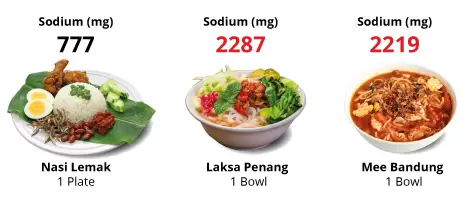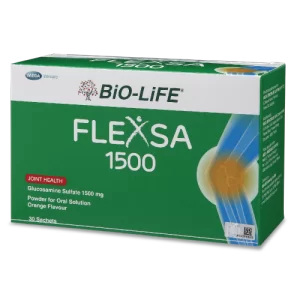
Limit Your Sodium Intake with Flexsa
Nov 27, 2018
Sodium in Everyday Malaysian Favorites
The perk of being Malaysian is we can enjoy variety kind of delicious food ranging from Malay, Chinese, and Indian cuisines to the special delights of different states such as Penang Laksa and Mee Bandung Muar. Nevertheless, most of the food that we commonly eat contain sodium which normally derived from sodium chloride (NaCl), the salt which we usually add to the food and monosodium glutamate (MSG). According to the Malaysian Adult Nutrition Survey (MANS) 2014, the average sodium intake among Malaysian adults is 1935mg/day¹. This figure is almost exceeding the recommended salt intake by the World Health Organization (WHO), 2000mg/day².

Figure 1: Sodium in Everyday Malaysian Favorites⁹
Sodium & Hypertension
One pinch of salt is equivalent to 400mg sodium, while 1 teaspoon of salt is equivalent to 2000mg sodium³. Sodium is an essential electrolyte that regulates blood volume and osmotic equilibrium in our body. However, excessive intake of sodium can cause fluid retention and subsequently increasing the blood pressure. Elevating blood pressure or hypertension is a condition whereby the systolic and diastolic blood pressure is equivalent to or greater than 140mmHg and 90 mmHg respectively⁴. Thus, individuals with hypertension must limit their sodium intake to 1500mg/day⁵.

Table 1: Blood Pressure Category⁴
The Hidden Salt
Indeed, we can cut the sodium intake by limiting it to half or 1 teaspoon of salt per day. However, most sodium in our diet presents in other forms such as MSG, sodium nitrate, and sodium benzoate in processed food, sauces, flavoring cubes, and even in glucosamine sulphate supplement. We call these forms of sodium as ‘hidden salt’. Therefore, it is important to read the ingredient list on the food and supplement label before consuming it especially if you are having high blood pressure.
Sodium-Free Glucosamine Sulfate
Glucosamine sulfate is considered as one of the essential supplements and serves as an adjuvant therapy for osteoarthritis. Normally, glucosamine sulfate is bind to salts such as sodium chloride (NaCl) and potassium chloride (KCl). For osteoarthritis patients with hypertension, the sodium content in glucosamine sulfate supplement must be taken into consideration. Therefore, you can make a smart choice by opting for sodium-free glucosamine sulfate with BiO-LiFE Flexsa!

BiO-LiFE Flexsa
BiO-LiFE Flexsa contains 1500mg crystalline glucosamine sulfate which is bind to potassium salt. Crystalline glucosamine sulfate works via anabolic and catabolic effects whereby it stimulates the synthesis of proteoglycans⁶, the building blocks of the cartilage matrix and depresses the cartilage degradation activities by inhibiting the action of catabolic enzymes⁷ respectively. It comes in a powder form and it is readily soluble in water. With these kinds of properties, crystalline glucosamine sulfate provides better absorption and higher bioavailability. After an oral administration, 90% of crystalline glucosamine sulfate will be absorbed in the bloodstream⁸. This form of glucosamine sulfate is high compliance for those who are having dysphagia as well.
References
- Institute for Public Health (IPH). National Health and Morbidity Survey 2014 : Malaysian Adult Nutrition Survey (MANS) Vol. II : Survey Findings : 343 pages.
- WHO. Guideline: Sodium intake for adults and children. 2012. Geneva: World Health Organization (WHO).
- Saxelby, C. How to convert sodium to salt (and salt to sodium). Retrieved from https://foodwatch.com.au/blog/measures-and-conversions/item/how-to-convert-sodium-to-salt-and-salt-to-sodium.html
- Clinical practice guidelines: Management of hypertension. (2013). Putrajaya: Kementerian Kesihatan Malaysia.
- American Heart Association. Shaking the Salt Habit to Lower High Blood Pressure. Retrieved from http://www.heart.org/en/health-topics/high-blood-pressure/changes-you-can-make-to-manage-high-blood-pressure/shaking-the-salt-habit-to-lower-high-blood-pressure
- Bassleer C., Rovati L., Franchimont P. 1998. Stimulation of proteoglycan production by glucosamine sulfate in chondrocytes isolated from human osteoarthritic articular cartilage in vitro. Osteoarthritis and Cartilage, 6(6):427-434
- Jimenez S.A. and Dodge G.R 1997. The effects of Glucosamine Sulfate (GSO4) on human chondrocyte gene expression. Osteoarthritis and Cartilage, 5:72
- Setnikar I. et al. 1993. Pharmacokinetics of glucosamine in man. Arzneimittelforschung, 43(10):1109-1113
- Foo, J. 2016. 23 Hawker Stall Dishes and Their Calories, Fat & Sodium Content. Retrieved from http://www.healthworks.my/infographic-hawker-stall/



